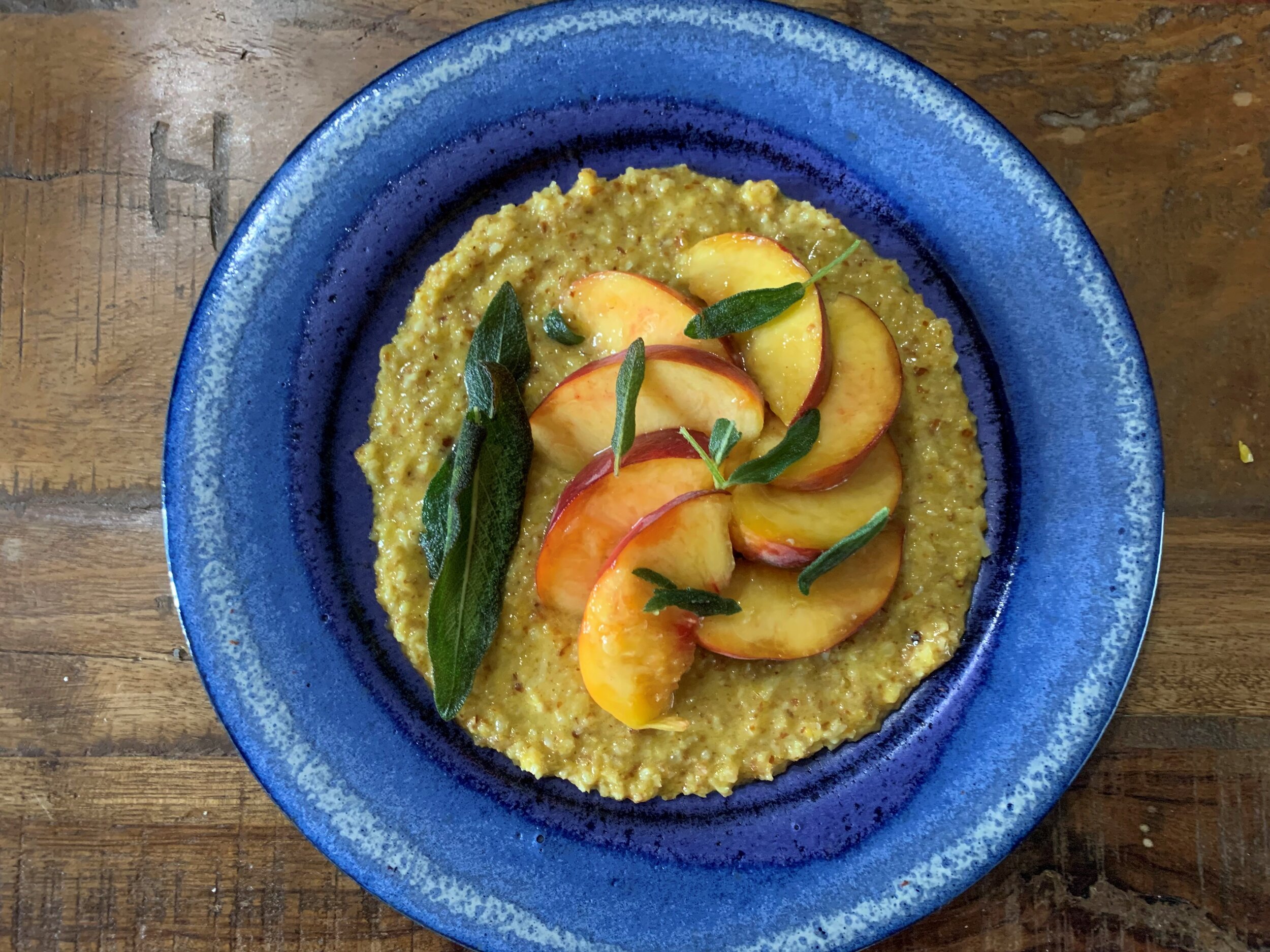Perfect Peaches with Almond Pesto
This dish has it all. It has the smoothness of ripened peaches, coarseness of almonds, earthiness and crispness of sage, brightness of citrus, sweetness of fruit and amaretto. It’s a Vivian Howard masterpiece from Deep Run Roots.
This salad is versatile. It can be the highlight of brunch, a starter for a dinner, or turn it into a dessert. Use the ripest and juiciest peaches for this dish. If you have mediocre peaches, this is not the best way to use them.
Warning: This dish contains uncooked alcohol. Good news is there are good substitutions so you can have it without – just read the notes section at the bottom of this post for more info.
Ingredients
1/3 c extra-virgin olive oil
20-24 fresh sage leaves
½ tsp salt (optional)
3 medium peaches
¼ c amaretto
Almond Pesto
2/3 c raw almonds
2-3 oranges (for zest and juice)
- 1 tsp zest
- ½ c orange juice
1/4 c olive oil
¼ c Parmigiano-Reggiano
¼ tsp red pepper flakes
¼ tsp nutmeg
¼ tsp salt
2 tsp honey
1 lemon (1 Tbl juice)
Directions
Heat a 10” frying pan on medium heat. Add the almonds (it’s ok if the pan isn’t too warm yet). Let them sit about a couple of minutes and flip them. Allow them to cook a little longer until they’re fragrant and slightly darker in color. The time is not meant to be literal. Factors that will determine timing are temperature of frying pan, temperature of the almonds when they hit the pan, and the size of the nut. Trust your eyes and nose and not the clock!
Zest the orange. If you don’t have a zester, use the smallest hole on a cheese grater. Just make sure you’re only grating the dark orange part off. The white stuff is bitter. Shred the cheese. Add the zest, parmesan, chili flakes, nutmeg, and salt to a food processor. There’s no need to pulse it quite yet.
Add the cooled nuts to a bowl and process until the nuts are coarsely chopped. You can determine how course you want the nuts, but try to have them uniform in shape. Don’t over pulse it though because we don’t want the mixture to become paste. Add honey, orange juice, 1/4 c olive oil and lemon juice. Pulse until combined.
Add oil to the frying pan that you used to cook the almonds. Heat it past the point the oil shimmers, but before it smokes. Drop a single sage leaf into the oil to do a temperature check. The edges should curl and the leaf get crispy in less than a minute. If the leaf turns brown and then crisps (opposed to crisping prior to that), your oil is not hot enough. Once you have the correct temperature, drop leaves into your pan. You don’t want to overcrowd it for 2 reasons: 1) you don’t want to drop the temperature of your oil too much 2) the sage cooks so quick you have a greater chance of burning leaves because you can’t remove them fast enough.
Slice the peaches. It’s a bit of a personal preference on the thickness of the wedges. Something to consider besides the amount of bite you want is the thinner the peach, the more surface area you’re creating for the amaretto to adhere to.
Spoon pesto over a flat plate, stack the peaches and sprinkle the sage pieces on top. Drizzle a little of the amaretto liquid on top. Make sure you get a bit of almond pesto and peach in each bite.
Notes
The peaches are soaked in amaretto so be cautious if kids will be around or those who don’t drink – make sure the dish is properly labeled. If you want to go sans alcohol, no problem – I usually don’t use it because I don’t keep amaretto on hand and I don’t want to buy a whole bottle for one dish. You can use amaretto extract or almond extract. If you have neither on hand, use vanilla. Remember to dilute the extract in water.
Nectarines are peaches that has a gene variation that causes smooth skin. I recommend going with the fruit that is more fragrant at time of choosing.
You can make the almond pesto up to a few days in advance.
Cut and soak the peaches not long before serving. Peaches oxidize so you don’t want to cut them too early.
Sage is a polarized flavor. If you don’t typically like it, I want you to try it because it goes so well with the other flavors in the dish. You don’t want a lot because if you’re adverse to it, the flavor can be over powering. Choose a small leaf or break a leaf into a small piece and try it with the pesto and peach. If you’re serving this buffet style, either have it on small plates already served and people take one or have a “sample” sitting out so they know what’s going on. Oh and if it is self-serve setting, have extra sage – the sage eaters often snack on the sage alone.

